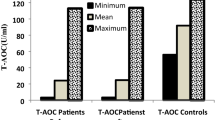Abstract
The relation between oxidative stress and tamoxifen is not completely clear, since some studies attribute a possible antioxidant action, while others describe several pro-oxidative effects. The aim of this study was to evaluate oxidative stress in patients treated with tamoxifen and the effect of administration of green tea catechins on this parameter. Tests aimed at evaluating the derivatives of reactive oxygen metabolites (d-Roms test) and the antioxidant reserve (BAP test) were adopted to estimate oxidative stress. Subjects treated with tamoxifen received Categ [Sofar] (green tea extract with 200 mg of catechins, 2 tablets twice a day for 3 weeks), according to a crossover design. High or very high antioxidant stress levels were found in all the 46 patients treated with tamoxifen, while in a control group of 18 patients treated with aromatase inhibitors or who had no longer been treated with tamoxifen for 1 year or more, high or very high oxidative stress levels were found in 66.7% of cases (p < 0.0001). The antioxidant reserve was low in 52% of patients treated with tamoxifen versus 40% of the patients in the control group, but the difference was not statistically significant (p = n.s.). The levels of oxidative stress and antioxidant reserve did not change significantly in a subgroup where the patients took Categ for 3 weeks followed by 3 weeks washout (group A), while there was a statistical significant reduction in the levels of oxidative stress (p < 0.05) and an increase in the antioxidant reserve (p < 0.01) in the subgroup where 3 weeks of no treatment were followed by 3 weeks of treatment with Categ (group B). In conclusion, our study confirms a pro-oxidant effect of tamoxifen. The supplementation with green tea catechins gave discordant results. A high number of variables might intervene in the delicate oxidative–reductive equilibrium of human beings and, despite progress achieved in the last few years, there are several aspects concerning the oxidative–reductive equilibrium that still have to be explained.








Similar content being viewed by others
References
(2002) Nolvadex [tamoxifen citrate]. In: Medwatch 2002 Safety Information Summaries. US Food and Drug Administration, Washington. http://www.fda.gov/medwatch/SAFETY/2002/safety02.htm#nolvad
Murata Y, Ogawa Y, Saibara T et al (2003) Tamoxifen-induced non-alcoholic steatohepatitis in patients with breast cancer: determination of a suitable biopsy site for diagnosis. Oncol Rep 10:97–100
Ogawa Y, Murata Y, Nishioka A et al (1998) Tamoxifen-induced fatty liver in patients with breast cancer. Lancet 351:725
Oien KA, Moffat D, Curry GW et al (1999) Cirrhosis with steatohepatitis after adjuvant tamoxifen. Lancet 353:36–37
Toler SM (2004) Oxidative stress plays an important role in the pathogenesis of drug-induced retinopathy. Exp Biol Med (Maywood) 229:607–615
Dragan YP, Fahey S, Nuwaysir E et al (1996) The effect of tamoxifen and two of its non-isomerizable fixed-ring analogs on multistage rat hepatocarcinogenesis. Carcinogenesis 17:585–594
Wiseman H (1995) Tamoxifen as an antioxidant and cardioprotectant. Biochem Soc Symp 61:209–219
Wiseman H, Paganga G, Rice-Evans C et al (1993) Protective actions of tamoxifen and 4-hydroxytamoxifen against oxidative damage to human low-density lipoproteins: a mechanism accounting for the cardioprotective action of tamoxifen? Biochem J 292:365–368
Brown NS, Bicknell R (2001) Hypoxia and oxidative stress in breast cancer. Oxidative stress: its effects on the growth, metastatic potential and response to therapy of breast cancer. Breast Cancer Res 3:323–327
Schiff R, Reddy P, Ahotupa M et al (2000) Oxidative stress and AP-1 activity in tamoxifen-resistant breast tumors in vivo. J Natl Cancer Inst 92:1926–1934
Parvez S, Tabassum H, Rehman H et al (2006) Catechin prevents tamoxifen-induced oxidative stress and biochemical perturbations in mice. Toxicology 225:109–118
Anjaneyulu M, Tirkey N, Chopra K (2003) Attenuation of cyclosporine-induced renal dysfunction by catechin: possible antioxidant mechanism. Ren Fail 25:691–707
Singh D, Chander V, Chopra K (2005) Protective effect of catechin on ischemia–reperfusion-induced renal injury in rats. Pharmacol Rep 57:70–76
Alberti A, Bolognini L, Macciantelli D et al (2000) The radical cation of N, N-diethyl-para-phenylendiamine: a possible indicator of oxidative stress in biological samples. Res Chem Intermed 26:253–267
Benzie IF, Strain JJ (1996) The ferric reducing ability of plasma (FRAP) as a measure of “antioxidant power”: the FRAP assay. Anal Biochem 15(239):70–76
Tabassum H, Parvez S, Rehman H et al (2007) Catechin as an antioxidant in liver mitochondrial toxicity: inhibition of tamoxifen-induced protein oxidation and lipid peroxidation. J Biochem Mol Toxicol 21:110–117
Ferlini C, Scambia G, Marone M et al (1999) Tamoxifen induces oxidative stress and apoptosis in oestrogen receptor-negative human cancer cell lines. Br J Cancer 79:257–263
Seely D, Mills EJ, Wu P et al (2005) The effects of green tea consumption on incidence of breast cancer and recurrence of breast cancer: a systematic review and meta-analysis. Integr Cancer Ther 4:144–155
Sartippour MR, Shao ZM, Heber D et al (2002) Green tea inhibits vascular endothelial growth factor (VEGF) induction in human breast cancer cells. J Nutr 132:2307–2311
Cornelli U, Terranova R, Luca S et al (2001) Bioavailability and antioxidant activity of some food supplements in men and women using the D-Roms test as a marker of oxidative stress. J Nutr 31:3208–3211
Acknowledgments
This study was partly supported by a Grant from Sofar S.p.A. Milan, Italy.
Conflict of interest
None.
Author information
Authors and Affiliations
Corresponding author
About this article
Cite this article
Ronzani, G., Giaretta, R. & Morello, M. Evaluation of oxidative stress and antioxidative action of green tea catechins in patients treated with tamoxifen: a randomized open-label, crossover study. Mediterr J Nutr Metab 4, 127–132 (2011). https://doi.org/10.1007/s12349-010-0020-0
Received:
Accepted:
Published:
Issue Date:
DOI: https://doi.org/10.1007/s12349-010-0020-0




